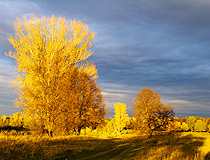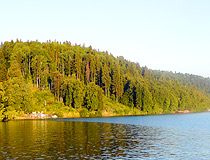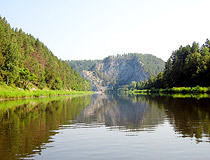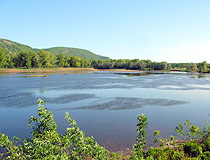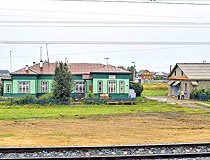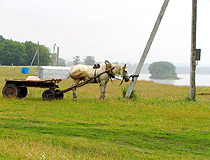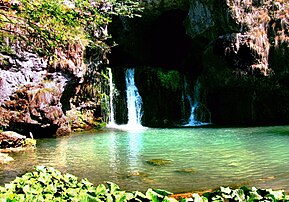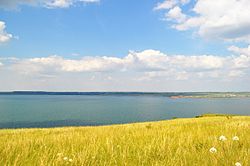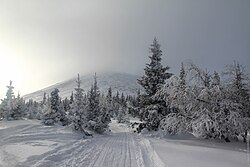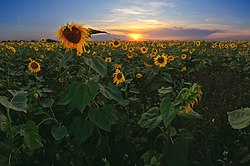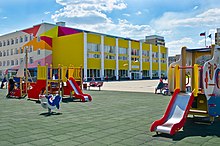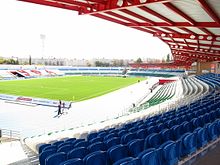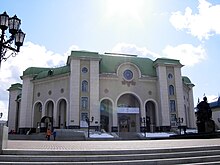Bashkortostan overview
Bashkortostan Republic or simply Bashkiria is a federal subject of Russia named after the Bashkir people. Located between the Ural mountains and the Volga River, on the border of Europe and Asia, the region is part of the Volga Federal District. Ufa is the capital city of the republic.
The population of Bashkiria is about 4,071,000 (2015), the area — 142,947 sq. km.
Bashkortostan history
The first people came to the territory of today’s Bashkiria at the beginning of the Palaeolithic. The population began to grow rapidly in the Bronze Age. The first permanent settlements in the southern part of the Ural Mountains were founded by people of Abashevo culture.
The word “Bashkirs” was first mentioned in the 9th century. Islam began to spread among the Bashkir population in the 10th century. It became the dominant religion in the region in the 14th century.
In the 13th-14th centuries, the territory on which Bashkirs lived was part of the Golden Horde. The Bashkirs had territorial autonomy as part of the Mongol Empire. After the collapse of the Golden Horde, the Bashkirs lived in the Nogai Horde, Kazan and Siberian khanates.
More Historical Facts…
By 1557, after the fall of Kazan (1552), the European part of Bashkortostan voluntarily joined Russia. By the middle of the 17th century, after the collapse of the Siberian Khanate, the remaining part of the territory of historical settlement of Bashkirs became part of Russia.
In 1865, Ufa guberniya was formed as part of the Russian Empire. In 1919, Bashkir Autonomous Soviet Socialist Republic was formed. In 1932, the first Bashkir oil was extracted and more oil deposits were discovered in 1943.
During the World War II, more than 100 industrial enterprises, dozens of hospitals, a number of central government agencies, 278 thousand refugees were evacuated to Bashkiria. After the war, engineering and oil production began to develop rapidly.
In the postwar period, several new towns (Salavat, Kumertau) were found as centers of development of petrochemical industry, mechanical engineering and aviation. In 1980, Ufa’s population exceeds one million people.
October 11, 1990, the Supreme Council of the Republic proclaimed the Declaration on State Sovereignty. In 1992, the region received a new name — the Republic of Bashkortostan.
Bashkortostan nature
Golden autumn in Bashkiria
Bashkiria — the land of lakes and forests
Author: Oleg Belyakov
Bashkortostan Republic scenery
Author: Ivan Shkalikov
Bashkiria features
Bashkortostan is located on the western slopes of the Southern Urals. The highest point is Yamantau Mountain (1,640 meters). The length of the region from north to south — 550 km, from west to east — 430 km. The republic borders on Perm krai, Sverdlovsk, Chelyabinsk, Orenburg regions, Tatarstan and Udmurtia republics.
Bashkiria has deposits of oil, natural gas, coal, iron ore, copper, zinc, gold, salt. Forests cover more than 40% of the territory. There are more than 12,000 rivers and 2,700 lakes, ponds and reservoirs on the territory of Bashkiria.
The climate is continental with humid, warm summers and moderately cold winters. The average temperature in January is minus 18 degrees Celsius, in July — plus 18 degrees Celsius.
The Republic of Bashkortostan has three reserves (Bashkir Reserve, South Ural Reserve, “Shulgan-Tash”), 12 medical plants reserves, 15 game reserves, the national park “Bashkiria”, two nature parks and over 150 natural monuments. The total area of protected areas is 1,226 thous. hectares (8.5% of the area of the region).
The largest cities of the republic are Ufa (1,105,000), Sterlitamak (280,000), Salavat (154,000), Neftekamsk (125,000), Oktyabrsky (113,600). National composition of Bashkortostan according to the National Population Census 2010: Russians (36,1%), Bashkirs (29.5%), Tatars (25.4%), Chuvash (2.7%), Mari (2.6%), Ukrainians (1%), people of other nationalities (2.7%).
In 2010, there were more than 1,000 functioning mosques in Bashkiria, over 200 Orthodox churches and more than 60 places of worship of other faiths.
Bashkiria views
Bashkortostan landscape
Author: Rinat Kurbanov
Rural Bashkiria — the view from the train window
Author: Sergey Bulanov
Bashkiria scenery
Author: Gennady Ionov
Bashkortostan economy and tourism
Bashkortostan is one of the most economically developed regions of Russia. The most important industries are oil production and refining, chemical and petrochemical, power engineering, wood processing and production of building materials.
Agriculture of Bashkiria includes cultivation of wheat, rye, oats, barley, sugar beets and sunflowers, cattle breeding, meat and wool sheep breeding, poultry farming, horse breeding, bee-keeping. Bashkir honey is well known throughout Russia.
Ufa is connected with Samara, Chelyabinsk, Orenburg, Ulyanovsk and other large Russian cities by railways. The highway M5 “Ural” crosses the region, M7 “Volga” ends in Ufa. The Belaya and the Ufa rivers are navigable.
Tourism resources of Bashkortostan: the monuments of culture and art in Ufa, Sterlitamak, Ishimbay, Salavat; about 300 karst caves, 600 rivers, 800 lakes; the ridges of the Ural Mountains (the oldest rock formations in Europe), three national reserves and the national park “Bashkiria”.
Ski resorts are located in Abzakovo and on Lake Bannoye. Shulgan-Tash is a cave with unique Paleolithic drawings.
|
|
This article needs to be updated. Please help update this article to reflect recent events or newly available information. (November 2022) |
|
Republic of Bashkortostan Республика Башкортостан |
|
|---|---|
|
Republic |
|
| Other transcription(s) | |
| • Bashkir | Башҡортостан Республикаһы |
|
Flag Coat of arms |
|
| Anthem: «State Anthem of the Republic of Bashkortostan»[2] |
|
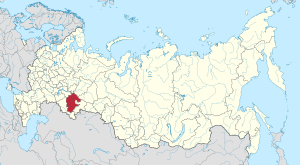 |
|
| Coordinates: 54°28′N 56°16′E / 54.467°N 56.267°ECoordinates: 54°28′N 56°16′E / 54.467°N 56.267°E | |
| Country | Russia |
| Federal district[1] | Volga |
| Economic region[3] | Ural |
| Capital | Ufa[4] |
| Government | |
| • Type | State Assembly-Kurultay[5] |
| • Head[5] | Radiy Khabirov[6] |
| Area
[7] |
|
| • Total | 142,947 km2 (55,192 sq mi) |
| Population
(2021 Census)[8] |
|
| • Total | |
| • Rank | 7th |
| • Density | 28.62/km2 (74.1/sq mi) |
| • Urban | 61.8% |
| • Rural | 38.2% |
| Time zone | UTC+5 (MSK+2[9]) |
| ISO 3166 code | RU-BA |
| Vehicle registration | 02, 102, 702 |
| Official language(s) | Russian,[10] Bashkir[11] |
| Website | http://www.bashkortostan.ru/ |
Bashkortostan, officially the Republic of Bashkortostan (Bashkir: Башҡортостан Республикаһы, romanized: Bashqortostan Respublikahy;[12][note 1] Russian: Республика Башкортостан, romanized: Respublika Bashkortostan),[a] also unofficially called Bashkiria (Russian: Башкирия, tr. Bashkiriya),[b] is a republic of Russia located between the Volga and the Ural Mountains in Eastern Europe. It covers 143,600 square kilometres (55,400 square miles) and has a population of 4 million. It is the seventh-most populous federal subject in Russia and the most populous republic.[13] Its capital and largest city is Ufa.
Bashkortostan was established on 28 November [O.S. 15 November] 1917.[14][15][16] On 20 March 1919 it was transformed into the Bashkir ASSR,[17] the first autonomous republic in the Russian SFSR.[18][19][20] On 11 October 1990, it adopted the Declaration of State Sovereignty. In the Constitution of Bashkortostan and Constitution of Russia, Bashkortostan is defined as a state.[21][22]
Terminology[edit]
The name «Bashkortostan» derives from the name of the Bashkir ethnic group. While the root of the name is Turkic (being a combination of ‘baş‘, which in Turkish can mean head, chief, main, principal and «qort» meaning wolf, one of the animals regarded as sacred to Turkic peoples);[citation needed] the suffix -stan is Persian, common to many Eurasian territorial names. The Bashkirs speak the Bashkir language, which belongs to the Kipchak branch of the Turkic language group.
History[edit]
The first settlements in the territory of modern Bashkortostan date from the early Paleolithic period, but the Bronze Age spurred an upsurge in the population of this territory.[23] When people of the Abashevo culture started settling here, they possessed high skills in manufacturing bronze tools, weapons and decorations. They were the first to establish permanent settlements in the Southern Urals.
Bashkortostan takes its name from its native people, the Bashkirs. The Slavonic name of the country, Bashkiriya, formed at the end of the 16th century. Originally it appeared in the forms Bashkir land, Bashkir, Bashkirda and Bashkir horde. The ethnonym Bashkirs first became known in the 7th century. In the 10th century, Al-Balkhi wrote about Bashkirs as a people, divided into two groups, one of which inhabited the Southern Urals, while the other lived near the Danube River, close to the boundaries of Byzantium. His contemporary Ibn-Ruste described the Bashkirs as «an independent people, occupying territories on both sides of the Ural mountain ridge between Volga, Kama, Tobol and upstream of Yaik River».
-
-
Mausoleum of Turahan, 14th-century building.
After the early-feudal Mongolian state had broken down in the 14th century, the territory of modern Bashkortostan became divided between the Kazan and Siberia Khanates and the Nogai Horde. The tribes that lived there were headed by bi (tribal heads). After Kazan fell to Ivan the Terrible in 1554–1555, representatives of western and northwestern Bashkir tribes approached the Tsar with a request to voluntarily join Muscovy.[citation needed]
Starting from the second half of the 16th century, Bashkiria’s territory began taking shape as a part of the Russian state. In 1798 the Spiritual Assembly of Russian Muslims was established, an indication that the tsarist government recognized the rights of Bashkirs, Tatars, and other Muslim nations to profess Islam and perform religious rituals. Ufa Governorate (guberniya), with a center in Ufa, was formed in 1865—another step towards territorial identification.
After the Russian Revolution of 1917 were All-Bashkir Qoroltays (conventions) on which a decision on the need to create a national federal republic within Russia. As a result, on 28 November 1917, the Bashkir Regional (Central) Shuro (Council) proclaimed the establishment of territorial and national autonomy in areas of Orenburg, Perm, Samara, and Ufa provinces with a predominantly Bashkir population.
In December 1917, delegates to the All-Bashkir (constituent) Congress, representing the interests of the population edge of all nationalities, voted unanimously for the resolution (Farman #2) of the Bashkir regional Shuro for the proclamation of national-territorial autonomy (of the Republic) Bashkurdistan. The congress formed the government of Bashkurdistan, the Pre-parliament—Kese-Qoroltay and other bodies of power and administration, and decisions were made on how to proceed.
In March 1919, based on the agreements of the Russian Government with the Bashkir Government was formed Bashkir Autonomous Soviet Socialist Republic. During the Soviet period, Bashkiria was granted broad autonomous rights—the first among other Russian regions. The administrative structure of the Bashkir ASSR was based on principles similar to those of other autonomous republics of Russia.
On 11 October 1990, the Supreme Soviet of the Republic adopted the declaration on state sovereignty of the Bashkir ASSR. On 25 February 1992, the Bashkir ASSR was renamed the Republic of Bashkortostan.
On 31 March 1992, a Federative Compact «On separation of authorities and powers among federal organs of power of the Russian Federation and the organs of power of the Republic of Bashkortostan» was signed. On 3 August 1994,[24] a Compact «On separation of authorities and mutual delegating of powers among the organs of power of the Russian Federation and the organs of power of the Republic of Bashkortostan» was signed, granting the republic autonomy. This agreement was abolished on 7 July 2005.[25]
Geography[edit]
Bashkortostan contains part of the southern Urals and the adjacent plains.
-
Shihan Toratau. Single hills are popular symbols of Bashkortostan.
-
Atysh waterfall
-
- Area: 143,600 square kilometers (55,400 sq mi) (according to the 2002 Census)
- Borders: Bashkortostan borders with Perm Krai (N), Sverdlovsk Oblast (NE), Chelyabinsk Oblast (NE/E/SE), Orenburg Oblast (SE/S/SW), the Republic of Tatarstan (W), and the Udmurt Republic (NW)
- Highest point: Mount Yamantau (1,638 m)
- Maximum North-South distance: 550 km
- Maximum East-West distance: over 430 km
Rivers[edit]
There are over 13,000 rivers in the republic. Many rivers are part of the deepwater transportation system of European Russia; they provide access to ports of the Baltic and Black seas.
Major rivers include:
- Belaya (Aghidhel) River (1,430 km)
- Ufa (Qaraidel) River (918 km)
- Sakmara River (760 km)
- Ik (Iq) River (571 km)
- Dyoma (Dim) River (556 km)
- Ay River (549 km)
- Yuruzan River (404 km)
- Bystry Tanyp River (345 km)
- Sim River (239 km)
- Nugush River (235 km)
- Tanalyk River (225 km)
- Zilim (Yethem) River (215 km)
- Syun River (209 km)
Lakes[edit]
There are 2,700 lakes and reservoirs in the republic. Major lakes and reservoirs include:
- Asylykül Lake (23.5 km2)
- Qandrykül Lake (15.6 km2)
- Urgun Lake (12.0 km2)
- Pavlovskoye Reservoir (120.0 km2)
- Nugushkoye Reservoir (25.2 km2)
Mountains[edit]
The Republic contains part of the southern Urals, which stretch from the northern to the southern border. The highest mountains include:
- Mount Yamantau (1,638 m)
- Mount Bolshoy Iremel (1,582 m)
- Mount Maly Iremel (1,449 m)
- Mount Arwyakryaz (1,068 m)
- Mount Zilmerdaq (909 m)
- Mount Alataw (845 m)
- Mount Yurmataw (842 m)
Natural resources[edit]
The Republic of Bashkortostan is one of the richest territories of Russia in mineral resources with deposits of some 3,000 mineral resources. Bashkortostan is rich in crude oil reserves, and is one of the principal centers of oil extraction in the Russian Federation. Other major resources are natural gas, coal, ferrous metal ores, manganese, chromite, iron ores, non-ferrous metals ores (lead, tungsten), non-metallic ores (rock crystal, fluorite, Iceland spar, sulfide pyrites, barite, silicates, silica, asbestos, talcum), deposits of precious and semi-precious stones and natural stones (malachite, jade, granite).
The republic has enough mineral resources to provide its power and fuel complex as well as petrochemical, chemical, agro-industrial complex, ferrous and non-ferrous metallurgy, glass-making and ceramic branches with raw materials.
Bashkortostan is one of the major raw materials bases for Russia non-ferrous metallurgy. The republic has good deposits of lignite with a high degree of bitumen. This lignite can be used for obtaining a variety of different chemical products like resins, surface-active substances, gummy fertilizers, and other stimulants for plant growth. Mining-chemical raw materials (rock salt, lime, phosphorites, barytes, etc.) are quite substantial, and are utilized in the republic economy.
Bashkortostan is also rich in woods. The total territory covered with forests is about 62,000 square kilometres (24,000 sq mi). More than one third of the republic territory is covered with woods. The following types of trees dominate: birch tree, conifers, lime, oak, and maple. The general stock of timber according to some evaluation is 717.9 million m3. Bashkortostan forests have special sanctuaries and national parks. They cover more than 10,000 square kilometres (3,900 sq mi).
Bashkortostan is also rich in springs and sources of mineral, medicinal, and drinking water.
The Asselian Age at the start of the Permian Period of geological time is named after the Assel River in Bashkortostan.[26]
Climate[edit]
- Average annual temperature: +0.3 °C (32.5 °F) (mountains) to +2.8 °C (37.0 °F) (plains)
- Average January temperature: −16 °C (3 °F)
- Average July temperature: +18 °C (64 °F)
Administrative divisions[edit]
Politics[edit]
The head of the government of the Republic of Bashkortostan is the Head (before 1 January 2015 the title was called «President»[27]). According to the Constitution, the Head of the Republic of Bashkortostan guarantees rights and liberties of the country’s people and citizens, protects economic and political interests of the Republic of Bashkortostan, and secures legitimacy, law, and order within its territory.
Since 11 October 2018, the head of the Head of the Republic of Bashkortostan has been Radiy Khabirov. He was first appointed as acting head by the Russian President Vladimir Putin. In 2019 he was officially elected after winning 82% of the vote in the 2019 Bashkir head election. The next election will be in 2024. Before his current role, Radiy Khabirov was the Head of Krasnogorsk, Moscow Oblast. His predecessor was Rustem Khamitov who was the leader since 19 July 2010. He resigned on 11 October 2018 ahead of the election because he personally decided to not run for re-election.[28]
The Republic’s parliament is the State Assembly—Kurultai, popularly elected every five years. The one-chamber State Assembly has 110 deputies.
The Republic’s Constitution was adopted on 24 December 1993. Article 1 of the Constitution stipulates that Bashkortostan is a sovereign state within Russia, it has state power beyond the limits of authority of the Russian Federation and the powers of the Russian Federation concerning the aspect of the joint authority of the Russian Federation and the Republic of Bashkortostan. The Republic of Bashkortostan is a full-fledged subject of the Russian Federation on equal and agreed bases.[citation needed]
The relations of the Republic of Bashkortostan and the Russian Federation are at present based on the articles of the Constitution of the Russian Federation, the Constitution of the Republic of Bashkortostan, the Federative Treaty (with amendments) and the Agreement on Separation of authorities and powers and mutual delegating of powers among the organs of state power of the Republic of Bashkortostan.
The judicial power of the republic is in the hands of the Constitutional Court, the Supreme Court, the Court of Appeals, District Courts, and justices of the peace.
In full accord with universally recognized principles of international law, articles of the European Charter of Local Self-Government and the Constitution of the Russian Federation, the Republic of Bashkortostan ensures in its Constitution that local self-government is recognized and guaranteed within the republic’s territory.[citation needed]
The Republic of Bashkortostan resolves all issues of administrative-territorial structure on its own. The list of districts and towns, municipalities, as well as the order of establishing, amending and changing borders of municipalities and their names, are stipulated by the Republic of Bashkortostan law «On administrative-territorial structure of the Republic of Bashkortostan and territory of municipalities».
The state has strong economic and cultural ties with its western neighbour, the Republic of Tatarstan.[29][30][31]
Economy[edit]
Bashkortostan is one of the most developed regions of the Russian Federation in terms of its cross regional output, the volume of industrial production, agricultural production, and investment in fixed assets.
The largest companies in the region include Bashneft (revenues of $9.57 billion in 2017), Ufa Engine Industrial Association (part of United Engine Corporation; $1.26 billion), Peton Holding ($1.04 billion), Bashkhim ($857 million), Ufaorgsintez ($473.07 million), Beloretsk Iron and Steel Works ($409.65 million).[32]
The extraction of crude oil in Bashkiria began in 1932. At the end of 1943 large crude oil deposits were discovered.[by whom?] During the Great Patriotic War of 1941 to 1945, Bashkiria became one of the major regions of the Soviet Union to accommodate plants and factories evacuated from Western Russia, as well as great masses of people, while also providing the country with weaponry, fuel, and foodstuffs. After the war, a number of industries developed further in Bashkiria, such as mining, machine-building and (especially) oil-refining. Bashkiria’s industry became a solid base for the further economic growth of all European outlying territories of Russia.
The economy of Bashkortostan, being one of the largest industrial centers of Russia, is very diverse. Bashkortostan has a large agricultural sector. But the republic’s most important industry is chemical processing; Bashkortostan produces more oil than any other region of Russia, about 26 million tons annually, and provides 17% of the country’s gasoline and 15% of its diesel fuel. Other important products manufactured in Bashkortostan include alcohols, pesticides, and plastics.
Bashkortostan’s gross regional product (GRP) in 2016 was 1.34 trillion rubles,[33] making the republic the subject with the ninth-highest GRP in Russia. The state had a positive trade balance, with $13.7 billion exported and $1.2 billion imported in 2013.[34] 82.9% of enterprises in Bashkortostan are profitable,[35] higher than the nationwide average of 68.42%. Bashkortostan has been recognized as the subject with the lowest economic risk.[36][37]
Bashkortostan is among the leaders in real estate development,[38] developed electric power industry[39] and tourism.[40]
According to Forbes, Ufa is the best city in Russia for business among cities with a population of over one million (2013).[41]
Structure of GRP[edit]
GRP structure of Bashkortostan for 2013.[42]
| Sector | % |
|---|---|
| Manufacturing | 36.2 |
| Wholesale and retail trade | 16.7 |
| Transport and communications | 7.3 |
| Real estate transactions | 7 |
| Construction | 6.9 |
| Agriculture | 6.5 |
| Education | 4.1 |
| Healthcare and social services | 4.1 |
| State management and social insurance | 3.8 |
| Mining | 2.8 |
| Production of electricity, gas, water | 2.4 |
| Hotels and restaurants | 1.1 |
| Other | 1.1 |
- Some industrial products of Bashkortostan
-
Tourism[edit]
The development of tourism in Bashkortostan is regulated by the main provisions of the Program …, regulatory and legal documents of the Russian Federation, as well as the «Concept for the development of tourist and recreational clusters in the Republic of Bashkortostan until 2030». Today, a lot of work continues to develop tourism and hospitality on the territory of the tourist and recreational cluster «North-East» of the Republic of Bashkortostan on the basis of the innovative scientific, educational and industrial infrastructure of the Geopark «Yangan-Tau».[43] The development of tourism and hospitality is possible on the basis of a multifunctional multidisciplinary center based on the Yangan-Tau and Toratau Geoparks (figures 1, 2). The Yangan-Tau Geopark was created in Bashkiria on October 18, 2017; it is the only one among the CIS countries that is included in the UNESCO Global Geoparks network. «Toratau» was created by the decree of the head of the region in December 2018. Then the authorities announced that the Geopark could become part of the UNESCO network, and a nomination dossier is currently being prepared.[44]
Demographics[edit]
Settlements[edit]
|
Largest cities or towns in Bashkortostan 2010 Russian Census |
|||||
|---|---|---|---|---|---|
| Rank | Administrative Division | Pop. | |||
 Ufa  Sterlitamak |
1 | Ufa | Ufimsky District | 1,062,319 |  Salavat  Neftekamsk |
| 2 | Sterlitamak | Sterlitamaksky District | 273,486 | ||
| 3 | Salavat | City of republic significance of Salavat | 156,095 | ||
| 4 | Neftekamsk | City of republic significance of Neftekamsk | 121,733 | ||
| 5 | Oktyabrsky | City of republic significance of Oktyabrsky | 109,474 | ||
| 6 | Beloretsk | Beloretsky District | 68,806 | ||
| 7 | Tuymazy | Tuymazinsky District | 66,836 | ||
| 8 | Ishimbay | Ishimbaysky District | 66,259 | ||
| 9 | Kumertau | Town of republic significance of Kumertau | 62,851 | ||
| 10 | Sibay | Town of republic significance of Sibay | 62,763 |
Bashkir village on the Inzer river.
Population development[edit]
Life expectancy at birth in Bashkortostan
| Year | Population |
|---|---|
| 1897 | 1,991,000 |
| 1913 | 2,811,000 |
| 1926 | 2,547,000 |
| 1939 | 3,158,000 |
| 1959 | 3,340,000 |
| 1970 | 3,818,000 |
| 1979 | 3,849,000 |
| 1989 | 3,950,482[45] |
| 2002 | 4,104,336[46] |
| 2010 | 4,072,292[13] |
| 2021 | 4,091,423[8] |
Vital statistics[edit]
- Source: Russian Federal State Statistics Service Archived April 12, 2008, at the Wayback Machine
| Average population (x 1000) | Live births | Deaths | Natural change | Crude birth rate (per 1000) | Crude death rate (per 1000) | Natural change (per 1000) | Total fertility rate | |
|---|---|---|---|---|---|---|---|---|
| 1970 | 3,817 | 63,498 | 28,004 | 35,494 | 16.6 | 7.3 | 9.3 | |
| 1975 | 3,825 | 63,096 | 31,802 | 31,294 | 16.5 | 8.3 | 8.2 | |
| 1980 | 3,850 | 67,743 | 36,067 | 31,676 | 17.6 | 9.4 | 8.2 | |
| 1985 | 3,868 | 76,839 | 39,101 | 37,738 | 19.9 | 10.1 | 9.8 | |
| 1990 | 3,952 | 63,899 | 38,157 | 25,742 | 16.2 | 9.7 | 6.5 | |
| 1991 | 3,975 | 58,240 | 39,638 | 18,602 | 14.7 | 10.0 | 4.7 | |
| 1992 | 4,005 | 53,271 | 43,539 | 9,732 | 13.3 | 10.9 | 2.4 | |
| 1993 | 4,030 | 46,772 | 50,738 | -3,966 | 11.6 | 12.6 | -1.0 | |
| 1994 | 4,050 | 47,296 | 54,267 | -6,971 | 11.7 | 13.4 | -1.7 | |
| 1995 | 4,074 | 45,622 | 51,734 | -6,112 | 11.2 | 12.7 | -1.5 | |
| 1996 | 4,091 | 45,228 | 49,600 | -4,372 | 11.1 | 12.1 | -1.1 | |
| 1997 | 4,103 | 43,776 | 49,354 | -5,578 | 10.7 | 12.0 | -1.4 | |
| 1998 | 4,113 | 44,465 | 48,470 | -4,005 | 10.8 | 11.8 | -1.0 | |
| 1999 | 4,119 | 41,368 | 52,608 | -11,240 | 10.0 | 12.8 | -2.7 | |
| 2000 | 4,117 | 41,642 | 53,550 | -11,908 | 10.1 | 13.0 | -2.9 | |
| 2001 | 4,112 | 42,793 | 55,001 | -12,208 | 10.4 | 13.4 | -3.0 | |
| 2002 | 4,104 | 45,481 | 57,836 | -12,355 | 11.1 | 14.1 | -3.0 | |
| 2003 | 4,095 | 45,583 | 58,237 | -12,654 | 11.1 | 14.2 | -3.1 | |
| 2004 | 4,084 | 45,733 | 57,726 | -11,993 | 11.2 | 14.1 | -2.9 | |
| 2005 | 4,074 | 44,094 | 57,787 | -13,693 | 10.8 | 14.2 | -3.4 | |
| 2006 | 4,064 | 45,055 | 55,319 | -10,264 | 11.1 | 13.6 | -2.5 | |
| 2007 | 4,060 | 51,453 | 55,144 | -3,691 | 12.7 | 13.6 | -0.9 | |
| 2008 | 4,059 | 54,493 | 55,568 | -1,075 | 13.4 | 13.7 | -0.3 | |
| 2009 | 4,062 | 55,587 | 53,227 | 2,360 | 13.7 | 13.1 | 0.6 | 1,74 |
| 2010 | 4,067 | 57,093 | 54,457 | 2,636 | 14.0 | 13.4 | 0.6 | 1,77 |
| 2011 | 4,072 | 55,806 | 54,432 | 1,374 | 13.7 | 13.4 | 0.3 | 1,74 |
| 2012 | 4,064 | 59,180 | 53,624 | 5,556 | 14.6 | 13.2 | 1.4 | 1.86 |
| 2013 | 4,065 | 59,260 | 53,346 | 5,914 | 14.6 | 13.1 | 1.5 | 1.89 |
| 2014 | 4,071 | 60,239 | 53,509 | 6,730 | 14.8 | 13.1 | 1.7 | 1.95 |
| 2015 | 4,072 | 59,196 | 54,107 | 5,087 | 14.5 | 13.3 | 1.2 | 1.94 |
| 2016 | 4,069 | 55,708 | 52,283 | 3,425 | 13.7 | 12.8 | 0.9 | 1.86(e) |
| 2017 | 4 065 | 49,260 | 50,261 | -1,001 | 12.1 | 12.3 | -0.2 | |
| 2018 | 47,044 | 50,473 | -3,429 | 11.6 | 12.4 | -0.8 | ||
| 2019 | 42,031 | 49,195 | -7,164 | 10.4 | 12.2 | -1.8 | ||
| 2020 | 41,043 | 60,211 | -19,168 | 10.2 | 15.0 | -4.8 |
Note: Total fertility rate 200-12 source.[47]
Ethnic groups[edit]
Bashkirs as the indigenous (autochthonal) peoples of Bashkortostan have the sole rights to self-determination.[48][49][50] According to the 2021 Census, the ethnic composition was:[51]
- Russians 37.5%
- Bashkirs 31.5%
- Volga Tatars 24.2%
- Mari 2.1%
- Chuvash 2.0%
- Udmurts 0.4%
- Ukrainians 0.4%
| Ethnic group |
1920 Census | 1926 Census | 1939 Census | 1959 Census | 1970 Census | 1979 Census | 1989 Census | 2002 Census | 2010 Census | 2021 Census1 | ||||||||||
|---|---|---|---|---|---|---|---|---|---|---|---|---|---|---|---|---|---|---|---|---|
| Number | % | Number | % | Number | % | Number | % | Number | % | Number | % | Number | % | Number | % | Number | % | Number | % | |
| Bashkirs | 807,213 | 40.13% | 625,845 | 23.5% | 671,188 | 21.2% | 737,744 | 22.1% | 892,248 | 23.4% | 935,880 | 24.3% | 863,808 | 21.9% | 1,221,302 | 29.8% | 1,172,287 | 29.5% | 1,268,806 | 31.5% |
| Russians | 794,131 | 39.48% | 1,064,707 | 39.9% | 1,281,347 | 40.6% | 1,418,147 | 42.4% | 1,546,304 | 40.5% | 1,547,893 | 40.3% | 1,548,291 | 39.3% | 1,490,715 | 36.3% | 1,432,906 | 36.1% | 1,509,246 | 37.5% |
| Tatars | 103,928 | 5.17% | 461,871 | 17.3% | 777,230 | 24.6% | 768,566 | 23.0% | 944,505 | 24.7% | 940,436 | 24.5% | 1,120,702 | 28.4% | 990,702 | 24.1% | 1,009,295 | 25.4% | 974,533 | 24.2% |
| Mari | 84,809 | 4.22% | 79,298 | 3.0% | 90,163 | 2.9% | 93,902 | 2.8% | 109,638 | 2.9% | 106,793 | 2.8% | 105,768 | 2.7% | 105,829 | 2.6% | 103,658 | 2.6% | 84,988 | 2.1% |
| Chuvash | 47,929 | 2.38% | 84,886 | 3.2% | 106,892 | 3.4% | 109,970 | 3.3% | 126,638 | 3.3% | 122,344 | 3.2% | 118,509 | 3.0% | 117,317 | 2.9% | 107,450 | 2.7% | 79,950 | 2.0% |
| Udmurts | 23,907 | 1.32% | 23,256 | 0.9% | 25,103 | 0.8% | 25,388 | 0.8% | 27,918 | 0.7% | 25,906 | 0.7% | 23,696 | 0.6% | 22,625 | 0.6% | 21,477 | 0.5% | 17,149 | 0.4% |
| Ukrainians | 57,024 | 2.84% | 76,710 | 2.9% | 99,289 | 3.1% | 83,594 | 2.5% | 76,005 | 2.0% | 75,571 | 2.0% | 74,990 | 1.9% | 55,249 | 1.3% | 39,875 | 1.0% | 14,876 | 0.4% |
| Others | 5,103 | 0.12% | 249,263 | 9.3% | 107,757 | 3.4% | 104,298 | 3.1% | 94,819 | 2.5% | 87,445 | 2.3% | 87,349 | 2.2% | 96,231 | 2.3% | 87,772 | 2.2% | 75,819 | 1.9% |
| 1 66,056 people were registered from administrative databases, and could not declare an ethnicity. It is estimated that the proportion of ethnicities in this group is the same as that of the declared group.[52] |
Languages[edit]
According to the 2021 Census, spoken languages: Russian (97%), Bashkir (23%) and Tatar (20%),.[53]
Religion[edit]
Islam is adhered to by a majority of the nation’s population[56] of Bashkir and Tatar descent. The Muslims of Bashkortostan follow the Sunni Hanafi school of Islamic law.
Most ethnic Russians, Chuvash, and Ukrainians are Orthodox Christians. Most Mari are Pagan. Non-religious people form a substantial part of any ethnic group in Bashkortostan. There are 13,000 Jews in the republic, with a historic synagogue in Ufa, and a new Jewish Community Center built in 2008.[57]
According to the 2012 Sreda survey which interviewed 56,900 people,[54] 58% of the population of Bashkortostan are Muslim, 17% adhere to the Russian Orthodox Church, 3% are unaffiliated generic Christians, 1% are Orthodox Christian believers without belonging to any church or members of other Orthodox churches, and 2% are adherents of the Slavic native faith (Rodnovery), the Mari native religion, Chuvash Vattisen Yaly or Tengrism. In addition, 4% of the population declare to be «spiritual but not religious», 5% are atheist, and 7% follow other religions or did not give an answer to the question.[54] Note, however, that this survey has been criticized as biased. It was conducted by the service «Sreda», which has ties to the Christian organizations.[58]
In 2010, there were over 1,000 mosques in Bashkortostan,[59] 200 Orthodox churches and 60 religious buildings of other confessions.[60]
Education[edit]
About sixty scientific organizations are active in the republic. Fundamental and applied scientific research is underway at twelve institutes of the Russian Academy of Sciences, twenty-nine institutes of different branches of industry, as well as numerous design bureaus and organizations, universities, and colleges.
The country’s system of popular education took shape over many centuries and reflects the Bashkir people’s folklore, national customs, and traditions. When Islam spread in Bashkiria in the 10th century, an educational system began to emerge gradually— primarily religious schools operated under the supervision of mosques (maktabeh and madrasah).
In addition, many institutions of higher education operate in the republic, including branches of 16 leading Russian universities and colleges. Specialists graduate with degrees in about 200 trades and professions.
Education is primarily in Russian and Bashkir.
Sport[edit]
Russian Premier League football club FC Ufa is from Ufa. KHL team Salavat Yulaev Ufa plays in the city, as does Supreme Hockey League teams Toros Neftekamsk and HC Gornyak Uchaly, Minor Hockey League team Tolpar Ufa and Russian Women’s Hockey League team Agidel. Russian Volleyball Super League team Ural and volleyball team Samrau-UGNTU are from Ufa. Russian Handball Super League team Ugntu-VNZM and Russian Women’s Handball Super League team Ufa-Alisa are from Ufa. Formula One driver Daniil Kvyat hails from Ufa. It was decided in 2018 to revive bandy.[61][62][63] There are even preliminary plans for building an indoor arena.[64]
Culture[edit]
Bashkir State Academic Theater of Drama in Ufa.
Bashkortostan is home to song and dance companies, a network of national theaters, museums, and libraries, and a number of annual folk festivals. The republic has seven Bashkir, four Russian, and two Tatar State Drama Theaters, a State Opera and Ballet Theater, a National Symphony Orchestra, «Bashkortostan» film studio, thirty philharmonic collectives, and the Bashkir State Folk Dance Ensemble.
The Bashkir School of Dance is well respected[citation needed], with many students receiving international awards at competitions in Russia and other countries. World-renowned ballet dancer Rudolf Nureyev, as a child, was encouraged to dance in Bashkir folk performances, and began his dancing career in Ufa.
Bashkir literature is the literary tradition of the Republic of Bashkortostan.[65][66][67]
There are many museums in the Republic where you can get acquainted with the history of the region. The National Museum of the Republic of Bashkortostan, the Bashkir Nesterov Art Museum, the Museum of Archeology and Ethnography are the largest of them.
See also[edit]
- Bashkir cuisine
- Kuvandyk corridor
- Shonqar
Notes[edit]
- ^ ; Bashkir: Башҡортостан Республикаһы; Russian: Респу́блика Башкортоста́н
- ^ Russian: Башки́рия
- ^ Alternatively, Başqortostan Respublikahı
References[edit]
- ^ Президент Российской Федерации. Указ №849 от 13 мая 2000 г. «О полномочном представителе Президента Российской Федерации в федеральном округе». Вступил в силу 13 мая 2000 г. Опубликован: «Собрание законодательства РФ», No. 20, ст. 2112, 15 мая 2000 г. (President of the Russian Federation. Decree #849 of May 13, 2000 On the Plenipotentiary Representative of the President of the Russian Federation in a Federal District. Effective as of May 13, 2000.).
- ^ Law #10-z
- ^ Госстандарт Российской Федерации. №ОК 024-95 27 декабря 1995 г. «Общероссийский классификатор экономических регионов. 2. Экономические районы», в ред. Изменения №5/2001 ОКЭР. (Gosstandart of the Russian Federation. #OK 024-95 December 27, 1995 Russian Classification of Economic Regions. 2. Economic Regions, as amended by the Amendment #5/2001 OKER. ).
- ^ Constitution of the Republic of Bashkortostan, Article 65
- ^ a b Constitution of the Republic of Bashkortostan, Article 6
- ^ «Путин назначил врио глав Курской области и Башкирии». Vedomosti.ru. October 11, 2018. Retrieved October 11, 2018.
- ^ Федеральная служба государственной статистики (Federal State Statistics Service) (May 21, 2004). «Territoriya, chislo rayonov, naselonnykh punktov i sel’skikh administratsiy po sub»yektam Rossiyskoy Federatsii» Территория, число районов, населённых пунктов и сельских администраций по субъектам Российской Федерации [Territory, Number of Districts, Inhabited Localities, and Rural Administration by Federal Subjects of the Russian Federation]. Всероссийская перепись населения 2002 года (All-Russia Population Census of 2002) (in Russian). Federal State Statistics Service. Archived from the original on September 28, 2011. Retrieved November 1, 2011.
- ^ a b «Оценка численности постоянного населения по субъектам Российской Федерации». Federal State Statistics Service. Retrieved September 1, 2022.
- ^ «Об исчислении времени». Официальный интернет-портал правовой информации (in Russian). Retrieved January 19, 2019.
- ^ Official throughout the Russian Federation according to Article 68.1 of the Constitution of Russia.
- ^ Constitution of the Republic of Bashkortostan, Article 1
- ^ «BASHKIR : Cyrillic script» (PDF). Transliteration.eki.ee. Retrieved March 2, 2022.
- ^ a b Russian Federal State Statistics Service (2011). Всероссийская перепись населения 2010 года. Том 1 [2010 All-Russian Population Census, vol. 1]. Всероссийская перепись населения 2010 года [2010 All-Russia Population Census] (in Russian). Federal State Statistics Service.
- ^ Национально-государственное устройство Башкортостана, 1917–1925 гг: Общее введение и Том 1 // Билал Хамитович Юлдашбаев, Китап, 2002, ISBN 5295029166, 9785295029165
- ^ Хрестоматия по истории Башкортостана: Документы и материалы с древнейших времен до 1917 года // Фарит Гумеров, «Китап», 2001
- ^ Зулькарнаева Е. З., Кульшарипова Н. М. Фарман. // Башкортостан: краткая энциклопедия. — Уфа: Башкирская энциклопедия, 1996. — С. 603. — 672 с. — ISBN 5-88185-001-7.
- ^ Administrative-Territorial Structure of the Union Republics. 1987., p. 25
- ^ БСЭ т.4 1950 год стр 347
- ^ Smele, Jonathan D. (November 19, 2015). Historical Dictionary of the Russian Civil Wars,1916–1926. Vol. 2. Rowman & Littlefield Publishers. p. 179. ISBN 978-1442252806.
- ^ The Encyclopedia Americana. Vol. 30. Danbury, Conn. : Grolier. 1984. p. 310. ISBN 0717201155.
- ^ «President of Russia». Archived from the original on January 8, 2016. Retrieved January 24, 2016.
- ^ «Konstitutsiya Respubliki Bashkortostan ot 24 dekabrya 1993 g. N VS-22/15 / Glava 1. Osnovy konstitutsionnogo stroya Respubliki Bashkortostan» Конституция Республики Башкортостан от 24 декабря 1993 г. N ВС-22/15 / Глава 1. Основы конституционного строя Республики Башкортостан [Constitution of the Republic of Bashkortostan dated December 24, 1993 N ВС-22/15 / Chapter 1. Fundamentals of the constitutional order of the Republic of Bashkortostan]. Constitution/garant/ru (in Russian). Retrieved January 24, 2016.
- ^ «Главархитектура г. Уфы – История г. Уфы». Gorodufa.ru.
- ^ Solnick, Steven (May 29, 1996). «Asymmetries in Russian Federation Bargaining» (PDF). The National Council for Soviet and East European Research: 12. Archived from the original (PDF) on August 28, 2017. Retrieved May 3, 2019.
- ^ Turner, Cassandra (May 2018). «We Never Said We’re Independent»: Natural Resources, Nationalism, and the Fight for Political Autonomy in Russia’s Regions (Undergraduate thesis). University of Mississippi. p. 49.
As the treaty was not successfully re-approved, Bashkortostan lost its autonomy on July 7th, 2005.
- ^ Lucas, Spencer G.; Zeigler, Kate E., eds. (2005). «The Nonmarine Permian». Bulletin of the New Mexico Museum of Natural History and Science. 30: 48.
- ^ «Parlamentarii Bashkirii prinyali Zakon «O Glave Respubliki Bashkortostan»» Парламентарии Башкирии приняли Закон «О Главе Республики Башкортостан» [Parliamentarians of Bashkiria adopted the Law «On the Head of the Republic of Bashkortostan»]. Bashinform.ru (in Russian). December 25, 2014. Archived from the original on January 9, 2015. Retrieved January 8, 2015.
- ^ «Glava Bashkirii Khamitov ushel v otstavku» Глава Башкирии Хамитов ушел в отставку [Head of Bashkiria Khamitov resigned]. Interfax.ru (in Russian).
- ^ «Prosmotr publikatsii : Respublika Tatarstan» Просмотр публикации : Республика Татарстан [View Publication : Republic of Tatarstan] (in Russian). Archived from the original on January 30, 2016. Retrieved January 24, 2016.
- ^ «IslamRF.ru: Татарстан и Башкортостан в первой половине 2012–го года: от альянса в экономике к сотрудничеству в сферах языка и религии». Islamrf.ru. Retrieved January 24, 2016.
- ^ «Президент РТ». Archived from the original on January 31, 2016. Retrieved January 24, 2016.
- ^ Выписки ЕГРЮЛ и ЕГРИП, проверка контрагентов, ИНН и КПП организаций, реквизиты ИП и ООО. СБИС (in Russian). Retrieved October 20, 2018.
- ^ «ВРП Башкирии в 2014 году преодолел новый рубеж — 1,3 трлн рублей». Bashinform.ru. March 12, 2015.
- ^ «Республика Башкортостан в цифрах и фактах». Pobashkirii.ru. Retrieved March 2, 2022.
- ^ «РЕЙТИНГ СОЦИАЛЬНО-ЭКОНОМИЧЕСКОГО ПОЛОЖЕНИЯ СУБЪЕКТОВ РФ ИТОГИ 2014 ГОДА» (PDF). Vid1..rian.ru. Retrieved March 2, 2022.
- ^ «Вести.Ru: Башкортостан признан регионом с минимальными экономическими рисками». Vesti.ru. Retrieved January 24, 2016.
- ^ «Title». Archived from the original on February 8, 2016. Retrieved August 24, 2015.
- ^ «Ввод жилья в России – 2014: рейтинг регионов по итогам III квартала». Top-rf.ru. Retrieved January 24, 2016.
- ^ «Сайт газеты «Республика Башкортостан» – Экономика – «Позеленеет» ли энергетика?». Resbash.ru. Archived from the original on January 30, 2016. Retrieved January 24, 2016.
- ^ «Республика Башкортостан» [Republic of Bashkortostan] (in Russian). Archived from the original on January 30, 2016. Retrieved January 24, 2016.
- ^ «30 luchshikh gorodov dlya biznesa — 2013» 30 лучших городов для бизнеса — 2013 [Top 30 Cities for Business 2013]. Forbes.ru (in Russian). Retrieved March 2, 2022.
- ^ «Валовой региональный продукт — Республика Башкортостан — Российская Федерация — knoema.com». Knoema.
- ^ Serova, O V; Kudinova, G E; Rozenberg, A G; Kudinov, A K; Lazareva, N V (July 1, 2021). «Development of Regional Tourism on the Example of the Republic of Bashkortostan». IOP Conference Series: Earth and Environmental Science. 818 (1). doi:10.1088/1755-1315/818/1/012046/meta. ISSN 1755-1315.
This article incorporates text from this source, which is available under the CC BY 3.0 license.
- ^ «Развитие двух геопарков в Башкирии оценили в 920 миллионов рублей». РБК (in Russian). Retrieved January 2, 2023.
- ^ Всесоюзная перепись населения 1989 г. Численность наличного населения союзных и автономных республик, автономных областей и округов, краёв, областей, районов, городских поселений и сёл-райцентров [All Union Population Census of 1989: Present Population of Union and Autonomous Republics, Autonomous Oblasts and Okrugs, Krais, Oblasts, Districts, Urban Settlements, and Villages Serving as District Administrative Centers]. Всесоюзная перепись населения 1989 года [All-Union Population Census of 1989] (in Russian). Институт демографии Национального исследовательского университета: Высшая школа экономики [Institute of Demography at the National Research University: Higher School of Economics]. 1989 – via Demoscope Weekly.
- ^ Russian Federal State Statistics Service (May 21, 2004). Численность населения России, субъектов Российской Федерации в составе федеральных округов, районов, городских поселений, сельских населённых пунктов – районных центров и сельских населённых пунктов с населением 3 тысячи и более человек [Population of Russia, Its Federal Districts, Federal Subjects, Districts, Urban Localities, Rural Localities—Administrative Centers, and Rural Localities with Population of Over 3,000] (XLS). Всероссийская перепись населения 2002 года [All-Russia Population Census of 2002] (in Russian).
- ^ «Katalog publikatsiy::Federal’naya sluzhba gosudarstvennoy statistiki» Каталог публикаций::Федеральная служба государственной статистики [Publications catalogue::Federal State Statistics Service] (in Russian). Archived from the original on December 24, 2018. Retrieved January 24, 2016.
- ^ «Self-determination and secession in constitutional law, CDL-INF(2000)002, 41st Meeting (Venice, 10–11 December 1999)». Venice Commission.
- ^ See: United Nations General Assembly Resolution 1514 in Wikisource
- ^ See: Chapter I – Purposes and Principles of Charter of the United Nations in Wikisource
- ^ «Национальный состав населения». Federal State Statistics Service. Retrieved December 30, 2022.
- ^ «ВПН-2010». Archived from the original on December 25, 2018. Retrieved January 24, 2016.
- ^ Russian Census 2002. 6. Владение языками (кроме русского) населением отдельных национальностей по республикам, автономной области и автономным округам Российской Федерации Archived November 4, 2006, at the Wayback Machine(Knowledge of languages other than Russian by the population of republics, autonomous oblast and autonomous districts)(in Russian)
- ^ a b c «Arena: Atlas of Religions and Nationalities in Russia». Sreda, 2012.
- ^ «2012 Arena Atlas Religion Maps». Ogonek. No. 34 (5243). August 27, 2012. Archived from the original on April 21, 2017. Retrieved April 21, 2017.
- ^ «IslamOnline, Islamic News, Islamic Finance and Business — Bashkortostan ripe for investment: Khamitov». Archived from the original on June 18, 2013. Retrieved May 29, 2012.
- ^ «Bashkortostan Jews Centered», Dateline World Jewry, World Jewish Congress, July/August 2008
- ^ «Sotsiologicheskiye oprosy «Sredy», ili kto zakazyvayet «magiyu tsifr»?!» Социологические опросы «Среды», или кто заказывает «магию цифр»?! [Opinion polls «Wednesday», or who orders the «magic of numbers»?!]. Ruskline.ru (in Russian). September 6, 2012.
- ^ «Интерфакс-Религия: Говорить о притеснении ислама в России кощунственно, считает Талгат Таджуддин». Interfax-religion.ru. Retrieved January 24, 2016.
- ^ «25.08.2010 :: События :: Духовное управление мусульман Республики Башкортостан – Официальный сайт». Dumrb.ru. Retrieved January 24, 2016.
- ^ «Google Translate». translate.google.co.uk.
- ^ «Google Translate». translate.google.co.uk. February 26, 2019.
- ^ «Google Translate». translate.google.co.uk.
- ^ «Google Translate». translate.google.co.uk.
- ^ Allen J. Frank (2012). Bukhara and the Muslims of Russia: Sufism, Education, and the Paradox of Islamic Prestige. Brill. p. 11. ISBN 9789004234901. Retrieved March 27, 2014.
Tatar and Bashkir literary works constitute a particularly rich body of indigenous historical sources of Inner Asia, particularly for the nineteenth and twentieth centuries
- ^ Julie Kavanagh (2011). Nureyev: The Life. Random House. p. 51. ISBN 9780307807342. Retrieved March 27, 2014.
A celebration of Bashkirian Literature and Art to be held in Moscow..
- ^ Christopher Barnes (2004). Boris Pasternak: A Literary Biography, Volume 2. Cambridge University Press. p. 118. ISBN 9780521520737. Retrieved March 27, 2014.
The main themes of the meeting were the discussion of the state of Byelorussian and Bashkirian literature..
Further reading[edit]
- Ilishev, Ildus G. (December 1998). «Russian federalism: Political, legal, and ethnolingual aspects — a view from the republic of Bashkortostan». Nationalities Papers. 26 (4): 723–759. doi:10.1080/00905999808408597. S2CID 155083799.
- Kropotkin, Peter Alexeivitch; Bealby, John Thomas (1911). «Ufa (government)» . Encyclopædia Britannica. Vol. 27 (11th ed.). pp. 556–557.
External links[edit]
- The centralized portal of the authorities of the Republic of Bashkortostan Archived July 22, 2011, at the Wayback Machine (in Russian)
- The Head of Republic of Bashkortostan
Сайфуллина Айгуль. Башкирская гимназия им. Ш.Бабича, Зилаир, Республика Башкортостан, Россия Сочинение на английском языке с переводом. Номинация Наш мир.
My name is Aygul Sayfullina. I`m seventeen years old and I live with my mum and dad in Bashkortostan. Have you ever heard of this republic? My republic is one of the largest sovereign republics within Russian Federation. It’s situated at the foot of the South Urals.
In the south Bashkortostan there is a small village, Zilair, where I was born and where I live now.
Bashkortostan is the great land. It is the pearl of the Urals. Our nature is nice and rich. There are many unique places of nature and every place is great.
There are more than thousand rivers in Bashkortostan. The main rivers are the Aghithel, the Karaithel, the Eyek, the Yurizan, the Hakmar and others. My native village is on the Zilair River.
Bashkortostan is rich in beautiful lakes. There are the Aslykul, the Kandrakul, the Talkath and others. The Talkath is the cleanest lake among others. There are beautiful forests around it. I can sit and enjoy the beauty of this lake by hours.
Bashkortostan is also famous for its caves. The Shulgan Tash cave is one of the famous ancient caves. It is the pride of Bashkortostan. It’s worth seeing.
The cave is not only a monument of nature, but also an original picture gallery. On its walls you can see the pictures of horses and different wild animals.
It is impossible to imagine the beauty of Bashkortostan’s nature without visiting the ancient place of Bashkorts. Everybody who visits Bashkortostan calls it the second Switzerland. I agree with them and I am proud of my republic.
The capital of my republic is a beautiful city Ufa. Ufa is one of the largest cities not only in Bashkortostan, but in Russia. Ufa today is a major industrial, agricultural, scientific and cultural centre of our Republic.
Ufa is a centre of science and education, too. There are a lot of universities, lyceums, gymnasiums, secondary schools and kindergartens.
There are many theatres, a philharmonic society, the Opera and Ballet Theatre, the circus, dozen of cinemas and cultural centres. There are many monuments and museums and other places of interest in Ufa. The Monument to Friendship is one of the places of interest in Ufa.
Ufa develops foreign economic relations in the fields of science, production and construction with companions from other countries, as well as republics and regions of Russia.
Bashkortostan is strong in oil and chemical industries and agriculture.
Bashkortostan is a sovereign republic within the Russian Federation. We have our own flag, national symbol and anthem.
Our national flag has three stripes on it. The stripes are blue, white and green. The upper stripe is blue, the middle stripe is white, and the green stripe is at the bottom. These colours have their symbolic meanings. The blue colour means honesty and devotion. The Bashkort people were always devoted to their friends, families and to the country. The white colour means nobility and sincerity to the Bashkort people. The green colour means the earth, freedom, wisdom of people and the eternity of life.
There is our golden symbol – the flower of the kurai in the centre of the white stripe. There are seven leaves of kurai on it. The flower of the kurai is the symbol of friendship, and the seven leaves mean consolidation and the unity of the people of the ancient Bashkortostan.
The State Symbol of the Republicof Bashkortostan is the monument to Salawat Yulayev against the background of the rising sun with a circle framed with the national ornament.
I am happy because our republic is beautiful, rich, beneficial and free and we have all the opportunities to work and study, to live and rest, to create and enjoy ourselves.
Bashkortostan, my land, my sky, Your mountains are very high. Bashkortostan, you are rich and dear, I am free and happy here. You give us food, And happy childhood. You give us your love, The sky is blue above. Bashkortostan – my native land, You always give your helping hand. Your heart is open for all of us, For our generous and kind friends.
More than180 nationalities live together in peace and friendship in a friendly multicultural family. I am proud of many talented writers, poets, composers, actors and actresses, scientists and other specialists from here.
I like reading books of Bashkir writers and poets. I like Mustay Karim most of all. His books teach us to live in friendship and agreement, to be kind and live in peace; to respect and understand each other. I like his poem «Not Russian, I was born on Russian Soil»
Not Russian, I was born on Russian Soil, And now I speak my mind, being strong and free, I drank the waters of Great Russian Rivers, And grew up sturdy as the green oak-tree. Proud of my life am I, and rightly so, The Russians destiny is ours forever…
Our Republic was awarded with two Orders of Lenin, the Order of October Revolution and the Friendship of Peoples.
I hope that you liked this story about my homeland Bashkortostan. And I invite everybody to visit this magical, great, beautiful, unique land.
Меня зовут Сайфуллина Айгуль. Мне семнадцать лет. Я живу в Башкортостане со своими родителями. Вы когда-нибудь слышали об этой республике? Это одна из самых больших суверенных республик в Российской Федерации, она расположена у подножия Уральских гор.
На юге Башкирии есть небольшое село Зилаир, где я родилась и живу по сей день.
Башкортостан — великолепная земля. Это жемчужина Урала, наша природа прекрасна и богата. У нас очень много уникальных мест, каждый из которых неповторим.
В Башкортостане более тысячи рек, главные из которых Агидель, Караидель, Яик, Юрюзань, Сакмара и многие другие. Мое родное село расположено на реке Зилаир.
Башкортостан богат красивыми озерами: Асылыкуль, Кандракуль, Талкаси многие другие. Все они окружены великолепными лесами. Я могу часами сидеть на берегу озера и наслаждать его неповторимостью.
Кроме того, Башкирия известна своими пещерами, Шульганташ — самая древняя из них. Это гордость республики, которую стоит увидеть.
Пещера не только памятник природы, но и уникалльная картинная галерея. На стенах можно увидеть изображения лошадей и других диких животных.
Невозможно представить красоту башкирской природы, не увидев древние места башкир. Каждый, кто посещает нашу республику, называет ее второй Швейцарией. Я согласна с ними и горжусь Башкирией.
Столицей моей республики является красивый город Уфа. Уфа один из самых больших городов не только Башкирии, но и России. Сегодня это крупный индустриальный, сельскохозяйственный, научный и культурный центр республики.
Также Уфа — это центр науки и образования. Здесь очень много университетов, лицеев, гимназий, средних школ, детских садов.
Очень много театров, филармоний, театров оперы и балета, цирков, дюжина кинотеатров и культурных центров. В Уфе много памятников и музеев. И Монумент Дружбы самый интересный из них.
Уфа развивает международные экономические отношения с компаниями других стран, а также сотрудничает и с другими регионами Российской Федерации.
В Башкортостане развита нефтяная и химическая промышленность, сельское хозяйство.
Башкирия — суверенная республика в пределах России. У нас есть свой флаг, национальный символ и гимн.
На нашем национальном флаге три полосы: голубая, белая и зеленая. Верхняя полоса зеленая, средняя белая, и нижняя зеленая. Каждый из этих цветов имеет свое значение. Голубой означает честность и преданность. Башкиры всегда были преданы друзьям, семье и стране. Белый — благородство и искренность башкирского народа. Зеленый — свободу и мудрость, вечность жизни.
Вцентре белой полосы расположен наш золотой символ — цветок курая. Семилепестковый цветок курая — символ дружелюбия, укрепления и единства народов Башкортостана.
Государственный гебр нашей республики — памятник Салавату Юлаеву на фоне восходящего солнца, лучи которого ограничены национальным орнаментом.
Я счастлива, потому что наша республика красивая, богатая, свободная, благотвораная, у нас есть все условия для работы и обучения, для жизни и отдыха, творчеcтва.
Башкортостан — моя земля, мое небо, Твои горы высоки. Башкортостан, ты богат и дорог мне, Я свободна и счастлива здесь. Ты даешь нам еду И счастливое детсво. Ты даешь нам свою любовь, Небо голубое над тобой. Башкортостан — моя родина, Ты всегда протянешьруку помощи. Твое сердце открыто для всех нас, Для благородных и добрых друзей.
Более чем 180 национальностей роживает в Башкортостане в мире и дружбе. Я горжусь талантливыми писателями и поэтами, композиторами, актерами и актриссами, учеными и другими профессионалами из республики.
Я люблю читать книгу башкирских писателей и поэтов. Больше других мне нравится Мустай Карим, потому что его книги учат нас жить в мире и согласии, быть добрее, уважать и понимать друг друга. Мне очень нарвится его стихотворение «Я — россиянин».
Не русский я, но россиянин. Ныне Я говорю, свободен и силен: Я рос, как дуб зеленый на вершине, Водою рек российских напоен. Своею жизнью я гордиться вправе — Нам с русскими одна судьба дана..
Наша республика награждена двумя Орденами Ленина, Орденом Октябрьской революции и Орденом Дружбы народов.
Я надеюсь, что что Вам понравилась история о моем родном Башкортостане. Я приглашаю всех посетить эту магическую, великолепную, красивую и уникальную землю.
Copyright © Russian centres of City and Guilds
Сообщение на классном часе на тему «Уфа-Столица Башкортостана»
Город Уфа- столица республики Башкортостан.
Уфа́
(башк.
Өфө
)) — один из крупнейших городов Российской Федерации, столица Республики Башкортостан
Численность населения — 1 105 667[3] чел. (2015).
Уфа — один из крупнейших экономических, культурных, спортивных, научных и религиозных центров России, важный транспортный узел
Флаг и Герб города Уфы с изображением куницы
История Уфы.
Строительство Уфимской крепости начато в 1574 году казанским воеводой Михаилом Александровичем Нагим, а городом он стал в 1586 году. Город Уфа расположен на берегу реки Белой, при впадении в неё рек Уфы и Дёмы. В 1865 году Уфа стала центром Уфимской губернии.
Название города на башкирском языке выглядит как ӨФӨ. В стилизованном виде это выглядит как три круга, перечеркнутых по вертикали (центральный) и горизонтали (крайние), при этом достаточно часто используется в оформлении. Из-за схожести стилизованного написания названия города на башкирском языке с головками ввернутых шурупов, город иногда в шутку называют «Три шурупа». Другая распространенная шутка гласит, что, если вас послали «на три буквы», то вам — в Уфу.
Знаменисти Уфы.
Писател С.Аксаков родился и провел детские годы в Уфе, писатель Мажит Гафуры жил и работал, Герой СССР Александр Матросов воспитывался в уфимском детдоме, известный танцовщик Рудольф Нуриев, поэт и писатель Мустай Карим и многие, многие знаменитости прославили Уфу.
И сегодня Уфа продолжает давать миру талантливых людей искусства, являясь родиной популярных музыкантов Юрия Шевчука, Земфиры, скрипача и дирижера Владимира Спивакова, писателя Сергея Довлатова, многих именитых спортсменов, общественных деятелей.
В 2015 году приняла саммиты Шанхайской организации сотрудничества и БРИКС
Достопримечательности и памятные места Уфы.
С Уфой тесно связана жизнь национального героя Башкортостана Салавата Юлаева, памятник которому был установлен в 1967 г. Скульптура народного монументалиста и художника Сосланбека Тавасиева является самой крупной конной статуей в Европе, достигая почти 10 метров в высоту.
Главный символ города (да, пожалуй, и всей республики — он изображен даже на государственном гербе) — великолепного памятника башкирскому национальному герою, одному из руководителей Крестьянской войны 1773—1775 гг., сподвижнику Емельяна Пугачёва и поэту-импровизатору Салавату Юлаеву (Салауат Юлаев. Памятник Салавату Юлаеву — самая крупная конная статуя в Европе. Когда въезжаешь в город, такое ощущение, что приветствует гостей города.
Это тоже Салават Юлаев, но уже без коня.
Уфимская соборная мечеть Ляля-Тюльпан
Монумент Дружбы
Башкирский академический театр драмы имени Мажита Гафури (и памятник ему же).
Гостиный двор
В Уфе очень много памятных и исторических мест. Конечно, Уфа не поражает воображение не старинной архитектурой, ни особенностью ландшафта, но это столица моей малой Родины и я люблю его за это. Я в Уфе был много раз. С Уфимского аэропорта до Сочи летела на самолете, с автовокзала уезжала домой, на железнодорожном вокзале встречала гостей, ходила по улицам города, любуясь памятниками и красотой и величием современной архитектуры, несколько раз с братом отдыхала в аквопарке, недавно ходила в цирк.
И везде я чувствовала себя, как дома. Это моя Родина и я люблю ее!


- Entertainment & Pop Culture
- Geography & Travel
- Health & Medicine
- Lifestyles & Social Issues
- Literature
- Philosophy & Religion
- Politics, Law & Government
- Science
- Sports & Recreation
- Technology
- Visual Arts
- World History
- On This Day in History
- Quizzes
- Podcasts
- Dictionary
- Biographies
- Summaries
- Top Questions
- Week In Review
- Infographics
- Demystified
- Lists
- #WTFact
- Companions
- Image Galleries
- Spotlight
- The Forum
- One Good Fact
- Entertainment & Pop Culture
- Geography & Travel
- Health & Medicine
- Lifestyles & Social Issues
- Literature
- Philosophy & Religion
- Politics, Law & Government
- Science
- Sports & Recreation
- Technology
- Visual Arts
- World History
- Britannica Classics
Check out these retro videos from Encyclopedia Britannica’s archives. - Demystified Videos
In Demystified, Britannica has all the answers to your burning questions. - #WTFact Videos
In #WTFact Britannica shares some of the most bizarre facts we can find. - This Time in History
In these videos, find out what happened this month (or any month!) in history. - Britannica Explains
In these videos, Britannica explains a variety of topics and answers frequently asked questions.
- Student Portal
Britannica is the ultimate student resource for key school subjects like history, government, literature, and more. - COVID-19 Portal
While this global health crisis continues to evolve, it can be useful to look to past pandemics to better understand how to respond today. - 100 Women
Britannica celebrates the centennial of the Nineteenth Amendment, highlighting suffragists and history-making politicians. - Britannica Beyond
We’ve created a new place where questions are at the center of learning. Go ahead. Ask. We won’t mind. - Saving Earth
Britannica Presents Earth’s To-Do List for the 21st Century. Learn about the major environmental problems facing our planet and what can be done about them! - SpaceNext50
Britannica presents SpaceNext50, From the race to the Moon to space stewardship, we explore a wide range of subjects that feed our curiosity about space!

